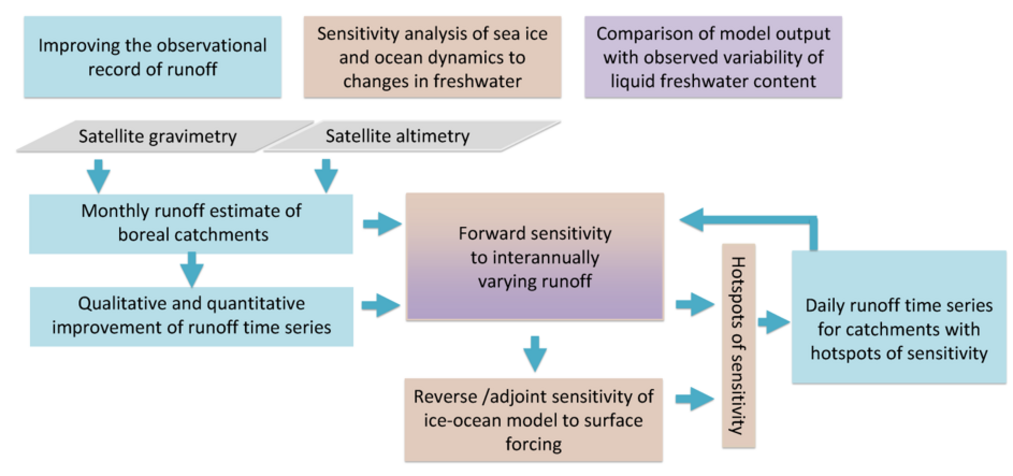RASLyBoCa
Response of Arctic sea level and hydrography to hydrological regime change over boreal catchments (RASLyBoCa)
Changes in freshwater influx into the Arctic Ocean are a key driver of regional dynamics and sea level change in the Arctic waters. Fresh surface waters maintain a strong stratification in the Arctic. This halocline largely shields the cool polar surface water and sea ice from the warmer waters of Atlantic origin below and hence inhibits vertical heat fluxes. Changes in the freshwater content are likely to affect regional steric sea level, but also the modified ocean dynamics may change sea level through mass transports within the Arctic.
The hydrological regime of river runoff appears to be non-stationary. However, the observational record of discharge into the Arctic Ocean is still too sparse to address important science questions into the long-term behaviour and development of Arctic sea level and climate.
Apart from in-situ observations and hydrological models, satellite gravimetry (GRACE) and satellite altimetry open up additional new avenues of observing the hydrology of large catchments literally by measuring the water storage over catchments and water level along rivers, which can be transformed into discharge through several methods. For ice-ocean models, the sparsity of runoff information (in the Arctic) generally requires that the seasonal cycle of runoff is assumed to the stationary. Here we propose to lift this assumption. We propose to use an ice-ocean general circulation model to study the impact of interannually varying runoff on the Arctic circulation and freshwater budget. This project will contribute to “mechanisms of sea level variability” and “local projections of sea level trends”. The main objective of the proposed study is to assess and quantify the response of Arctic sea level and hydrography to hydrological regime change over boreal catchments. The project objectives contribute to the strategy of the Priority Research Programme 1889 by
- Improving the observational record of hydrological parameters over boreal catchments by geodetic spaceborne methods (time varying gravimetry, satellite altimetry). Achieving long and dense time series of runoff for all major catchments draining into the Arctic Ocean.
- Sensitivity analysis of sea ice and ocean dynamics to changes in freshwater forcing (including runoff). To this end a pan-Arctic model will be configured and methods of forward perturbations (stationary vs. interannually varying runoff) will be combined with adjoint methods, where the sensitivity of global objective functions, e.g. global or regional freshwater content or sea level, to all forcing parameters is assessed through single adjoint model simulations.
- Comparison of model output in relation to changes in continental runoff with observed variability of liquid freshwater content (and resulting steric height changes) in the Arctic Ocean and the North Atlantic since 1990. Not only do these comparisons serve as model evaluation, but they will also help interpreting comparatively sparse oceanographic in-situ records.
-
The aforementioned objectives address the following work programmes of SPP1889:
-
Work Program A: Origin of regional sea level changes at annual to multi-decadal scale; in particular Topic I (Origin of regional sea level changes at decadal-to-centennial time scale): we will quantify natural variability using observations and calibrated reconstructions; we will determine the role of climate modes (e.g., Arctic Oscillation, NAO) in river discharge; we will quantify of the role of ocean circulation in shaping regional sea level changes; we will investigate the causes of contemporary regional sea level change in the ocean and in the terrestrial hydrological cycle; and Topic IV (Observations and calibrated reconstructions): we will improve the observational record of mass balance estimates in shelf sea regions (drainage basin scale).
-
Work Program B: Regionalization of Decadal Sea Level projections, in particular Topic I (Coastal Sea Level Projections): we will contribute to understanding the role of coastal and ocean interior processes on local sea level.
The RASLyBoCa project is also a member of the Focusgroup Cryosphere and Sea Level (FCS).

